Ford Motors: PESTEL, SWOT, Digital Leadership & Org. Success
VerifiedAdded on 2023/04/08
|20
|4206
|355
Report
AI Summary
This report provides a comprehensive analysis of Ford Motors, examining its external environment through PESTEL analysis (Political, Economic, Sociocultural, Technological, Environmental, and Legal factors) and internal environment using SWOT analysis (Strengths, Weaknesses, Opportunities, and Threats). It delves into Ford's market challenges, marketing strategies, and competitive positioning within the automotive industry. The report also explores the impact of digital leadership at Ford Motors, highlighting the strategies implemented by CEO Alan Mulally to drive organizational transformation and improve the company's performance, including fostering innovation, enhancing communication, and integrating teams. The analysis further discusses the characteristics of a successful digital leader and offers recommendations for Ford to sustain its market share and competitiveness. Desklib is a platform where students can find more solved assignments and past papers.
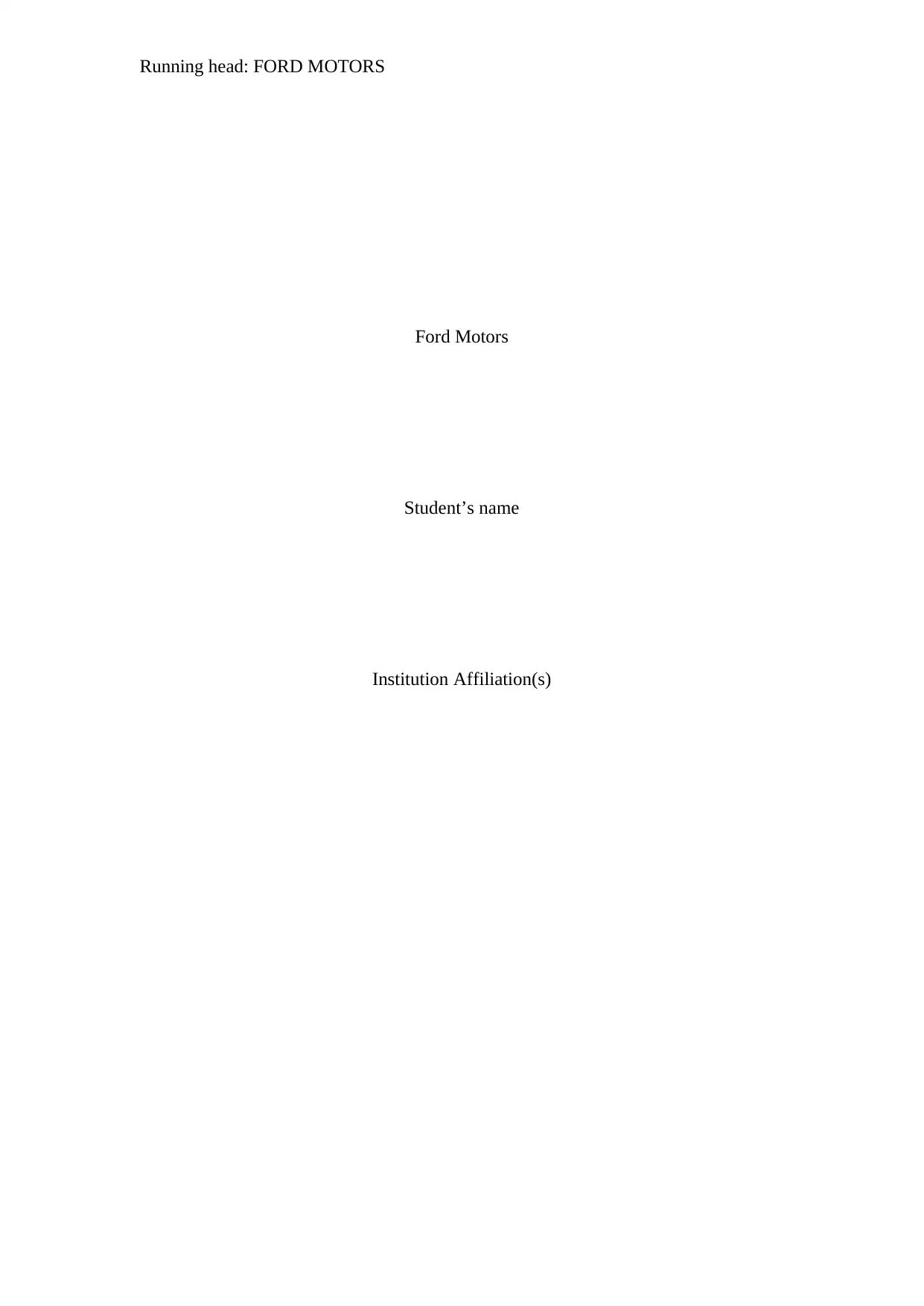
Running head: FORD MOTORS
Ford Motors
Student’s name
Institution Affiliation(s)
Ford Motors
Student’s name
Institution Affiliation(s)
Paraphrase This Document
Need a fresh take? Get an instant paraphrase of this document with our AI Paraphraser

FORD MOTORS
Table of Contents
List of Abbreviations.....................................................................................................2
Ford Motors....................................................................................................................3
PESTEL Analysis of Ford Company.............................................................................4
Political Factors..........................................................................................................4
Economic Factors.......................................................................................................4
Sociocultural Factors..................................................................................................5
Technological Factors................................................................................................5
Environmental Factors...............................................................................................5
Legal Factors..............................................................................................................6
SWOT Analysis of Ford Motors....................................................................................6
Strengths.....................................................................................................................6
Weaknesses................................................................................................................6
Opportunities..............................................................................................................7
Threats........................................................................................................................7
Digital Leadership at Ford Motors.................................................................................7
How Digital Leadership is impacting organizational success....................................7
What makes a successful digital leader and how digital leaders lead successful
organizational transformations.................................................................................11
Recommendations........................................................................................................14
Conclusions..................................................................................................................14
References....................................................................................................................16
Appendices...................................................................................................................19
Appendix (i): Graph of U.S Market Share by Company..........................................19
Appendix (ii): Graph of European Market Share by Company...............................19
1
Table of Contents
List of Abbreviations.....................................................................................................2
Ford Motors....................................................................................................................3
PESTEL Analysis of Ford Company.............................................................................4
Political Factors..........................................................................................................4
Economic Factors.......................................................................................................4
Sociocultural Factors..................................................................................................5
Technological Factors................................................................................................5
Environmental Factors...............................................................................................5
Legal Factors..............................................................................................................6
SWOT Analysis of Ford Motors....................................................................................6
Strengths.....................................................................................................................6
Weaknesses................................................................................................................6
Opportunities..............................................................................................................7
Threats........................................................................................................................7
Digital Leadership at Ford Motors.................................................................................7
How Digital Leadership is impacting organizational success....................................7
What makes a successful digital leader and how digital leaders lead successful
organizational transformations.................................................................................11
Recommendations........................................................................................................14
Conclusions..................................................................................................................14
References....................................................................................................................16
Appendices...................................................................................................................19
Appendix (i): Graph of U.S Market Share by Company..........................................19
Appendix (ii): Graph of European Market Share by Company...............................19
1
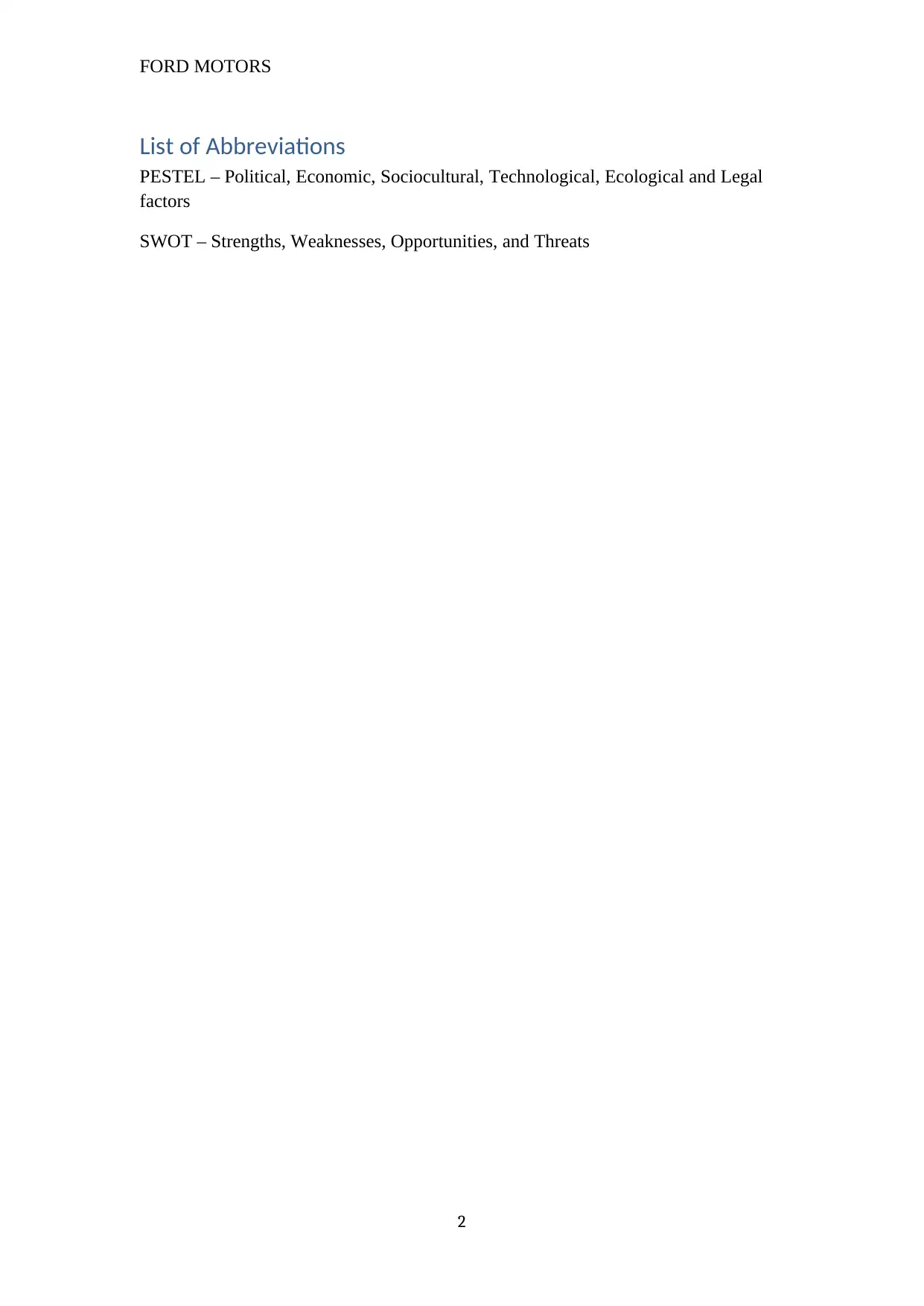
FORD MOTORS
List of Abbreviations
PESTEL – Political, Economic, Sociocultural, Technological, Ecological and Legal
factors
SWOT – Strengths, Weaknesses, Opportunities, and Threats
2
List of Abbreviations
PESTEL – Political, Economic, Sociocultural, Technological, Ecological and Legal
factors
SWOT – Strengths, Weaknesses, Opportunities, and Threats
2
⊘ This is a preview!⊘
Do you want full access?
Subscribe today to unlock all pages.

Trusted by 1+ million students worldwide
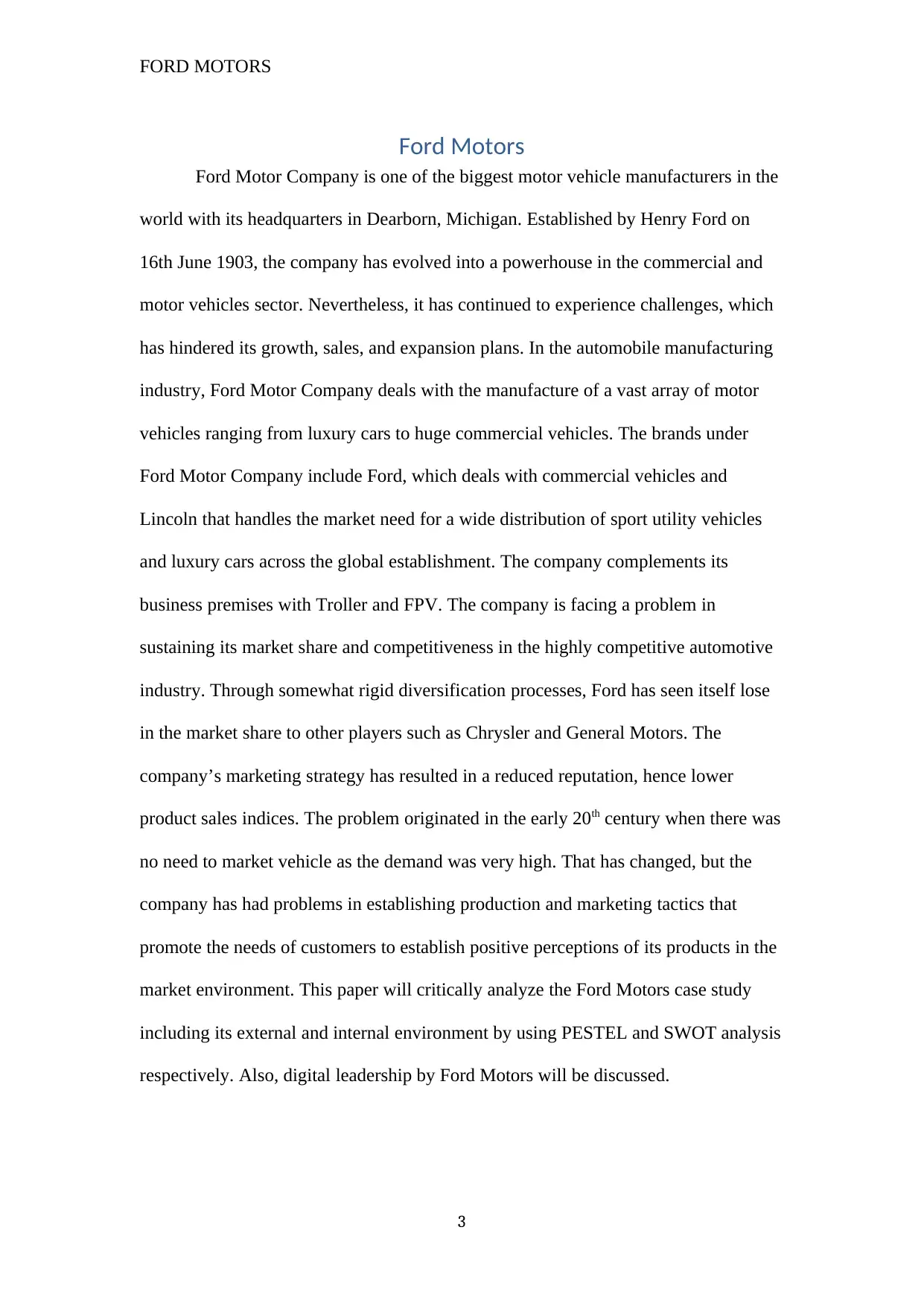
FORD MOTORS
Ford Motors
Ford Motor Company is one of the biggest motor vehicle manufacturers in the
world with its headquarters in Dearborn, Michigan. Established by Henry Ford on
16th June 1903, the company has evolved into a powerhouse in the commercial and
motor vehicles sector. Nevertheless, it has continued to experience challenges, which
has hindered its growth, sales, and expansion plans. In the automobile manufacturing
industry, Ford Motor Company deals with the manufacture of a vast array of motor
vehicles ranging from luxury cars to huge commercial vehicles. The brands under
Ford Motor Company include Ford, which deals with commercial vehicles and
Lincoln that handles the market need for a wide distribution of sport utility vehicles
and luxury cars across the global establishment. The company complements its
business premises with Troller and FPV. The company is facing a problem in
sustaining its market share and competitiveness in the highly competitive automotive
industry. Through somewhat rigid diversification processes, Ford has seen itself lose
in the market share to other players such as Chrysler and General Motors. The
company’s marketing strategy has resulted in a reduced reputation, hence lower
product sales indices. The problem originated in the early 20th century when there was
no need to market vehicle as the demand was very high. That has changed, but the
company has had problems in establishing production and marketing tactics that
promote the needs of customers to establish positive perceptions of its products in the
market environment. This paper will critically analyze the Ford Motors case study
including its external and internal environment by using PESTEL and SWOT analysis
respectively. Also, digital leadership by Ford Motors will be discussed.
3
Ford Motors
Ford Motor Company is one of the biggest motor vehicle manufacturers in the
world with its headquarters in Dearborn, Michigan. Established by Henry Ford on
16th June 1903, the company has evolved into a powerhouse in the commercial and
motor vehicles sector. Nevertheless, it has continued to experience challenges, which
has hindered its growth, sales, and expansion plans. In the automobile manufacturing
industry, Ford Motor Company deals with the manufacture of a vast array of motor
vehicles ranging from luxury cars to huge commercial vehicles. The brands under
Ford Motor Company include Ford, which deals with commercial vehicles and
Lincoln that handles the market need for a wide distribution of sport utility vehicles
and luxury cars across the global establishment. The company complements its
business premises with Troller and FPV. The company is facing a problem in
sustaining its market share and competitiveness in the highly competitive automotive
industry. Through somewhat rigid diversification processes, Ford has seen itself lose
in the market share to other players such as Chrysler and General Motors. The
company’s marketing strategy has resulted in a reduced reputation, hence lower
product sales indices. The problem originated in the early 20th century when there was
no need to market vehicle as the demand was very high. That has changed, but the
company has had problems in establishing production and marketing tactics that
promote the needs of customers to establish positive perceptions of its products in the
market environment. This paper will critically analyze the Ford Motors case study
including its external and internal environment by using PESTEL and SWOT analysis
respectively. Also, digital leadership by Ford Motors will be discussed.
3
Paraphrase This Document
Need a fresh take? Get an instant paraphrase of this document with our AI Paraphraser
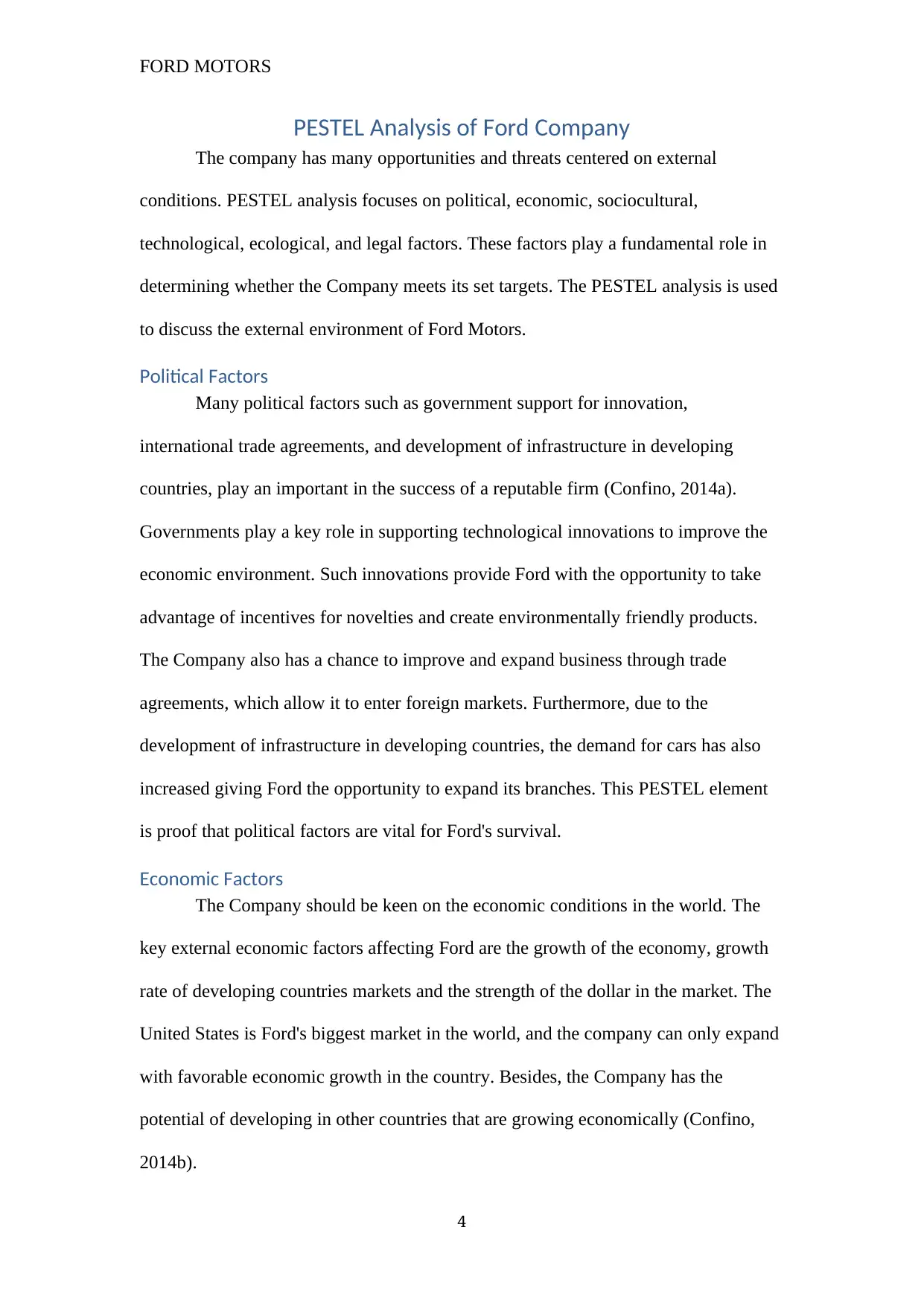
FORD MOTORS
PESTEL Analysis of Ford Company
The company has many opportunities and threats centered on external
conditions. PESTEL analysis focuses on political, economic, sociocultural,
technological, ecological, and legal factors. These factors play a fundamental role in
determining whether the Company meets its set targets. The PESTEL analysis is used
to discuss the external environment of Ford Motors.
Political Factors
Many political factors such as government support for innovation,
international trade agreements, and development of infrastructure in developing
countries, play an important in the success of a reputable firm (Confino, 2014a).
Governments play a key role in supporting technological innovations to improve the
economic environment. Such innovations provide Ford with the opportunity to take
advantage of incentives for novelties and create environmentally friendly products.
The Company also has a chance to improve and expand business through trade
agreements, which allow it to enter foreign markets. Furthermore, due to the
development of infrastructure in developing countries, the demand for cars has also
increased giving Ford the opportunity to expand its branches. This PESTEL element
is proof that political factors are vital for Ford's survival.
Economic Factors
The Company should be keen on the economic conditions in the world. The
key external economic factors affecting Ford are the growth of the economy, growth
rate of developing countries markets and the strength of the dollar in the market. The
United States is Ford's biggest market in the world, and the company can only expand
with favorable economic growth in the country. Besides, the Company has the
potential of developing in other countries that are growing economically (Confino,
2014b).
4
PESTEL Analysis of Ford Company
The company has many opportunities and threats centered on external
conditions. PESTEL analysis focuses on political, economic, sociocultural,
technological, ecological, and legal factors. These factors play a fundamental role in
determining whether the Company meets its set targets. The PESTEL analysis is used
to discuss the external environment of Ford Motors.
Political Factors
Many political factors such as government support for innovation,
international trade agreements, and development of infrastructure in developing
countries, play an important in the success of a reputable firm (Confino, 2014a).
Governments play a key role in supporting technological innovations to improve the
economic environment. Such innovations provide Ford with the opportunity to take
advantage of incentives for novelties and create environmentally friendly products.
The Company also has a chance to improve and expand business through trade
agreements, which allow it to enter foreign markets. Furthermore, due to the
development of infrastructure in developing countries, the demand for cars has also
increased giving Ford the opportunity to expand its branches. This PESTEL element
is proof that political factors are vital for Ford's survival.
Economic Factors
The Company should be keen on the economic conditions in the world. The
key external economic factors affecting Ford are the growth of the economy, growth
rate of developing countries markets and the strength of the dollar in the market. The
United States is Ford's biggest market in the world, and the company can only expand
with favorable economic growth in the country. Besides, the Company has the
potential of developing in other countries that are growing economically (Confino,
2014b).
4

FORD MOTORS
Nonetheless, the United States dollar has the potential of reducing the
Company's profits since most materials used in production come from the United
States. Such conditions put pressure on the company to improve business competency
in foreign countries (Rahimi, Møller, & Hvam, 2016).
Sociocultural Factors
Ford's Command in the market is dependent on social conditions. The
sociocultural factors that affect Ford include, increase in demand for motor vehicles,
attitude on customer service and growth in the wealth gap. The company can only
grow by innovating products such as electric and hybrid cars that are in high demand.
The firm also has the chance to improve sales by providing excellent after sale
services. Nonetheless, the increasing wealth gap in the world is a growing threat to the
firm
Technological Factors
Technology has enabled the Company to come up with innovations and
compete in the market. The rise in mobile computing, services, and limited alternative
gas stations have affected it. An increase in the use of mobile calculations has created
numerous prospects for Ford to develop through mobile advertisement and service
sustenance. Vehicles parts can also be delivered through online arrangement services.
Conversely, the company's dream of creating cars that use alternative fuel may suffer
due to limited stations to power the cars (Mendling et al., 2017).
Environmental Factors
Ecological factors such as climate change, short-carbon trend, and reducing oil
reserves affect the company's operation. Climatic change in the world has provided
the company with an opportunity to grow through creating environmentally friendly
products. Besides, the company can build machines that use alternative energy to
compensate for the declining oil reserves in the world (Rushe, 2019).
5
Nonetheless, the United States dollar has the potential of reducing the
Company's profits since most materials used in production come from the United
States. Such conditions put pressure on the company to improve business competency
in foreign countries (Rahimi, Møller, & Hvam, 2016).
Sociocultural Factors
Ford's Command in the market is dependent on social conditions. The
sociocultural factors that affect Ford include, increase in demand for motor vehicles,
attitude on customer service and growth in the wealth gap. The company can only
grow by innovating products such as electric and hybrid cars that are in high demand.
The firm also has the chance to improve sales by providing excellent after sale
services. Nonetheless, the increasing wealth gap in the world is a growing threat to the
firm
Technological Factors
Technology has enabled the Company to come up with innovations and
compete in the market. The rise in mobile computing, services, and limited alternative
gas stations have affected it. An increase in the use of mobile calculations has created
numerous prospects for Ford to develop through mobile advertisement and service
sustenance. Vehicles parts can also be delivered through online arrangement services.
Conversely, the company's dream of creating cars that use alternative fuel may suffer
due to limited stations to power the cars (Mendling et al., 2017).
Environmental Factors
Ecological factors such as climate change, short-carbon trend, and reducing oil
reserves affect the company's operation. Climatic change in the world has provided
the company with an opportunity to grow through creating environmentally friendly
products. Besides, the company can build machines that use alternative energy to
compensate for the declining oil reserves in the world (Rushe, 2019).
5
⊘ This is a preview!⊘
Do you want full access?
Subscribe today to unlock all pages.

Trusted by 1+ million students worldwide
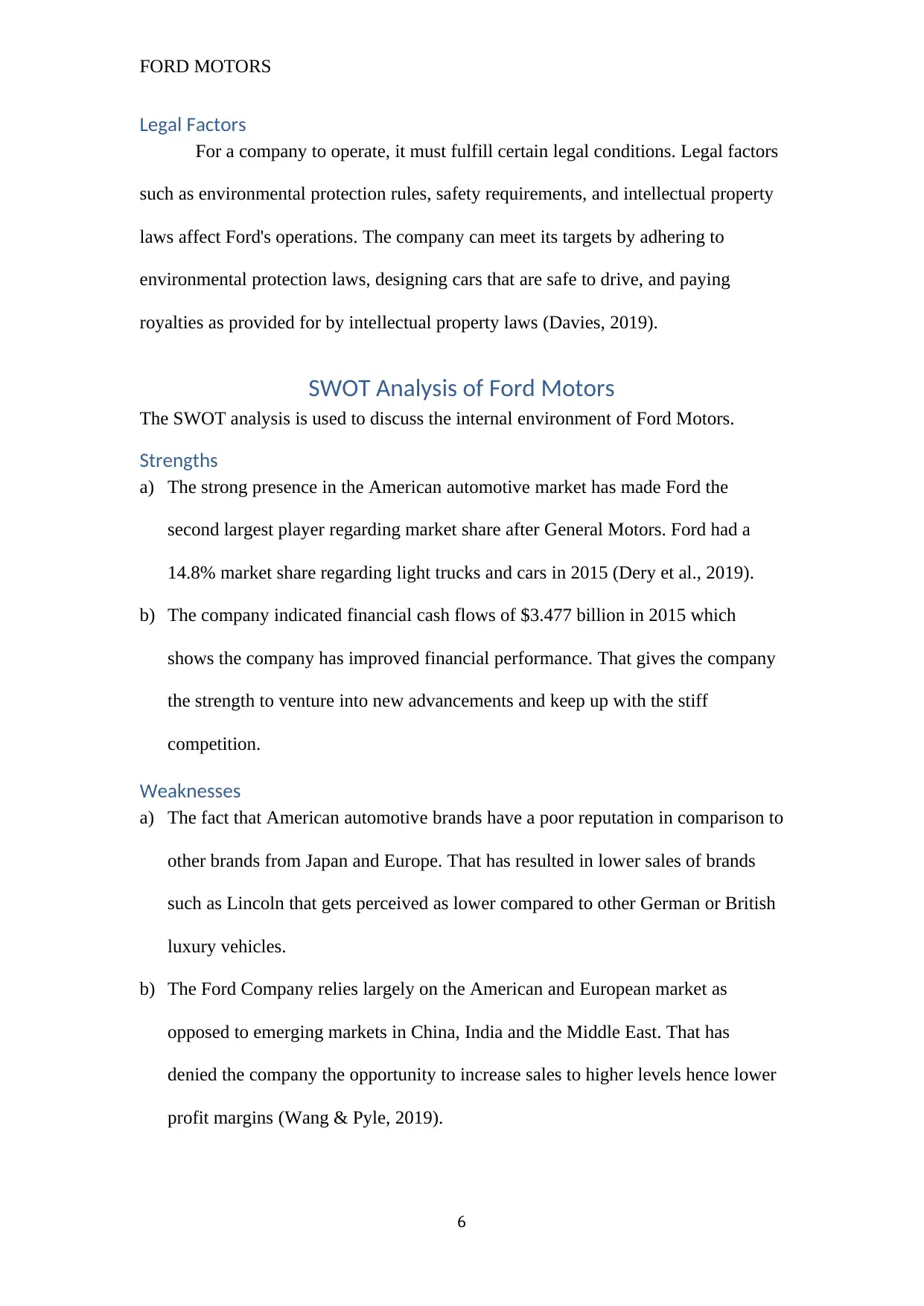
FORD MOTORS
Legal Factors
For a company to operate, it must fulfill certain legal conditions. Legal factors
such as environmental protection rules, safety requirements, and intellectual property
laws affect Ford's operations. The company can meet its targets by adhering to
environmental protection laws, designing cars that are safe to drive, and paying
royalties as provided for by intellectual property laws (Davies, 2019).
SWOT Analysis of Ford Motors
The SWOT analysis is used to discuss the internal environment of Ford Motors.
Strengths
a) The strong presence in the American automotive market has made Ford the
second largest player regarding market share after General Motors. Ford had a
14.8% market share regarding light trucks and cars in 2015 (Dery et al., 2019).
b) The company indicated financial cash flows of $3.477 billion in 2015 which
shows the company has improved financial performance. That gives the company
the strength to venture into new advancements and keep up with the stiff
competition.
Weaknesses
a) The fact that American automotive brands have a poor reputation in comparison to
other brands from Japan and Europe. That has resulted in lower sales of brands
such as Lincoln that gets perceived as lower compared to other German or British
luxury vehicles.
b) The Ford Company relies largely on the American and European market as
opposed to emerging markets in China, India and the Middle East. That has
denied the company the opportunity to increase sales to higher levels hence lower
profit margins (Wang & Pyle, 2019).
6
Legal Factors
For a company to operate, it must fulfill certain legal conditions. Legal factors
such as environmental protection rules, safety requirements, and intellectual property
laws affect Ford's operations. The company can meet its targets by adhering to
environmental protection laws, designing cars that are safe to drive, and paying
royalties as provided for by intellectual property laws (Davies, 2019).
SWOT Analysis of Ford Motors
The SWOT analysis is used to discuss the internal environment of Ford Motors.
Strengths
a) The strong presence in the American automotive market has made Ford the
second largest player regarding market share after General Motors. Ford had a
14.8% market share regarding light trucks and cars in 2015 (Dery et al., 2019).
b) The company indicated financial cash flows of $3.477 billion in 2015 which
shows the company has improved financial performance. That gives the company
the strength to venture into new advancements and keep up with the stiff
competition.
Weaknesses
a) The fact that American automotive brands have a poor reputation in comparison to
other brands from Japan and Europe. That has resulted in lower sales of brands
such as Lincoln that gets perceived as lower compared to other German or British
luxury vehicles.
b) The Ford Company relies largely on the American and European market as
opposed to emerging markets in China, India and the Middle East. That has
denied the company the opportunity to increase sales to higher levels hence lower
profit margins (Wang & Pyle, 2019).
6
Paraphrase This Document
Need a fresh take? Get an instant paraphrase of this document with our AI Paraphraser
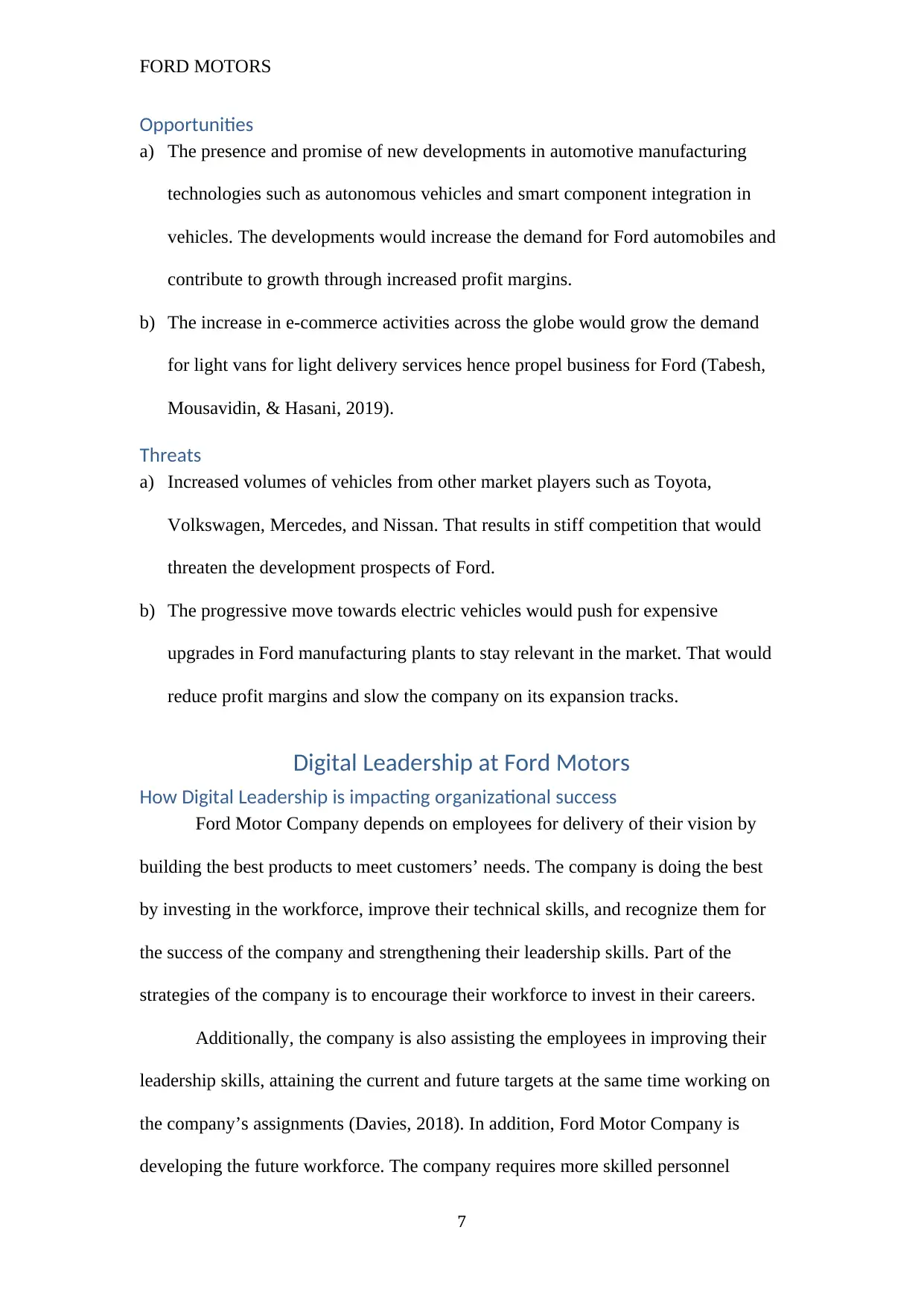
FORD MOTORS
Opportunities
a) The presence and promise of new developments in automotive manufacturing
technologies such as autonomous vehicles and smart component integration in
vehicles. The developments would increase the demand for Ford automobiles and
contribute to growth through increased profit margins.
b) The increase in e-commerce activities across the globe would grow the demand
for light vans for light delivery services hence propel business for Ford (Tabesh,
Mousavidin, & Hasani, 2019).
Threats
a) Increased volumes of vehicles from other market players such as Toyota,
Volkswagen, Mercedes, and Nissan. That results in stiff competition that would
threaten the development prospects of Ford.
b) The progressive move towards electric vehicles would push for expensive
upgrades in Ford manufacturing plants to stay relevant in the market. That would
reduce profit margins and slow the company on its expansion tracks.
Digital Leadership at Ford Motors
How Digital Leadership is impacting organizational success
Ford Motor Company depends on employees for delivery of their vision by
building the best products to meet customers’ needs. The company is doing the best
by investing in the workforce, improve their technical skills, and recognize them for
the success of the company and strengthening their leadership skills. Part of the
strategies of the company is to encourage their workforce to invest in their careers.
Additionally, the company is also assisting the employees in improving their
leadership skills, attaining the current and future targets at the same time working on
the company’s assignments (Davies, 2018). In addition, Ford Motor Company is
developing the future workforce. The company requires more skilled personnel
7
Opportunities
a) The presence and promise of new developments in automotive manufacturing
technologies such as autonomous vehicles and smart component integration in
vehicles. The developments would increase the demand for Ford automobiles and
contribute to growth through increased profit margins.
b) The increase in e-commerce activities across the globe would grow the demand
for light vans for light delivery services hence propel business for Ford (Tabesh,
Mousavidin, & Hasani, 2019).
Threats
a) Increased volumes of vehicles from other market players such as Toyota,
Volkswagen, Mercedes, and Nissan. That results in stiff competition that would
threaten the development prospects of Ford.
b) The progressive move towards electric vehicles would push for expensive
upgrades in Ford manufacturing plants to stay relevant in the market. That would
reduce profit margins and slow the company on its expansion tracks.
Digital Leadership at Ford Motors
How Digital Leadership is impacting organizational success
Ford Motor Company depends on employees for delivery of their vision by
building the best products to meet customers’ needs. The company is doing the best
by investing in the workforce, improve their technical skills, and recognize them for
the success of the company and strengthening their leadership skills. Part of the
strategies of the company is to encourage their workforce to invest in their careers.
Additionally, the company is also assisting the employees in improving their
leadership skills, attaining the current and future targets at the same time working on
the company’s assignments (Davies, 2018). In addition, Ford Motor Company is
developing the future workforce. The company requires more skilled personnel
7

FORD MOTORS
specialized in the technical field of study. Considering the challenges that the
company witnessed in its early performance until the beginning of 2006, the top
managerial group of Ford Motors decided to appoint Mr. Allan Mulally as their new
CEO. Mr. Alan Mulally was previously associated with the Boeing Company and was
quite well known in the corporate due to his effective turnaround strategies which
enabled the airline company to regain its growth. With the same focus, the new CEO
amended a few changes within the organization. However, he supported the
borrowing which according to his perception shall prove to be a cushion for the
company during the then most probable occurrence of a global recession (Jolly,
2019).
The leadership style which Mr. Alan Mulally introduced to the company was
largely similar to the framework of decentralized flow of information within the
managerial group. Certain initiations which were undertaken by him were:
a) Meetings between the top management group and the middle-level
management group to be held at frequent intervals (most likely to be every
month)
b) Integrating each and every department of the corporation as a single team
c) A fresh plan to stimulate almost every field of operation, i.e., manufacturing,
assembling, and manufacturing (Pitelis & Wagner, 2019).
d) A statement specifying the newly developed goals and the mission and vision
of the organization
After joining Ford Motors, Mr. Alan Mulally stated that the company was
facing certain significant challenges which he intended to overcome with an
advantageous strategic alliance. He initiated to simplify the organizational structure of
Ford by integrating all the diversified objectives to one goal and pertain single
8
specialized in the technical field of study. Considering the challenges that the
company witnessed in its early performance until the beginning of 2006, the top
managerial group of Ford Motors decided to appoint Mr. Allan Mulally as their new
CEO. Mr. Alan Mulally was previously associated with the Boeing Company and was
quite well known in the corporate due to his effective turnaround strategies which
enabled the airline company to regain its growth. With the same focus, the new CEO
amended a few changes within the organization. However, he supported the
borrowing which according to his perception shall prove to be a cushion for the
company during the then most probable occurrence of a global recession (Jolly,
2019).
The leadership style which Mr. Alan Mulally introduced to the company was
largely similar to the framework of decentralized flow of information within the
managerial group. Certain initiations which were undertaken by him were:
a) Meetings between the top management group and the middle-level
management group to be held at frequent intervals (most likely to be every
month)
b) Integrating each and every department of the corporation as a single team
c) A fresh plan to stimulate almost every field of operation, i.e., manufacturing,
assembling, and manufacturing (Pitelis & Wagner, 2019).
d) A statement specifying the newly developed goals and the mission and vision
of the organization
After joining Ford Motors, Mr. Alan Mulally stated that the company was
facing certain significant challenges which he intended to overcome with an
advantageous strategic alliance. He initiated to simplify the organizational structure of
Ford by integrating all the diversified objectives to one goal and pertain single
8
⊘ This is a preview!⊘
Do you want full access?
Subscribe today to unlock all pages.

Trusted by 1+ million students worldwide
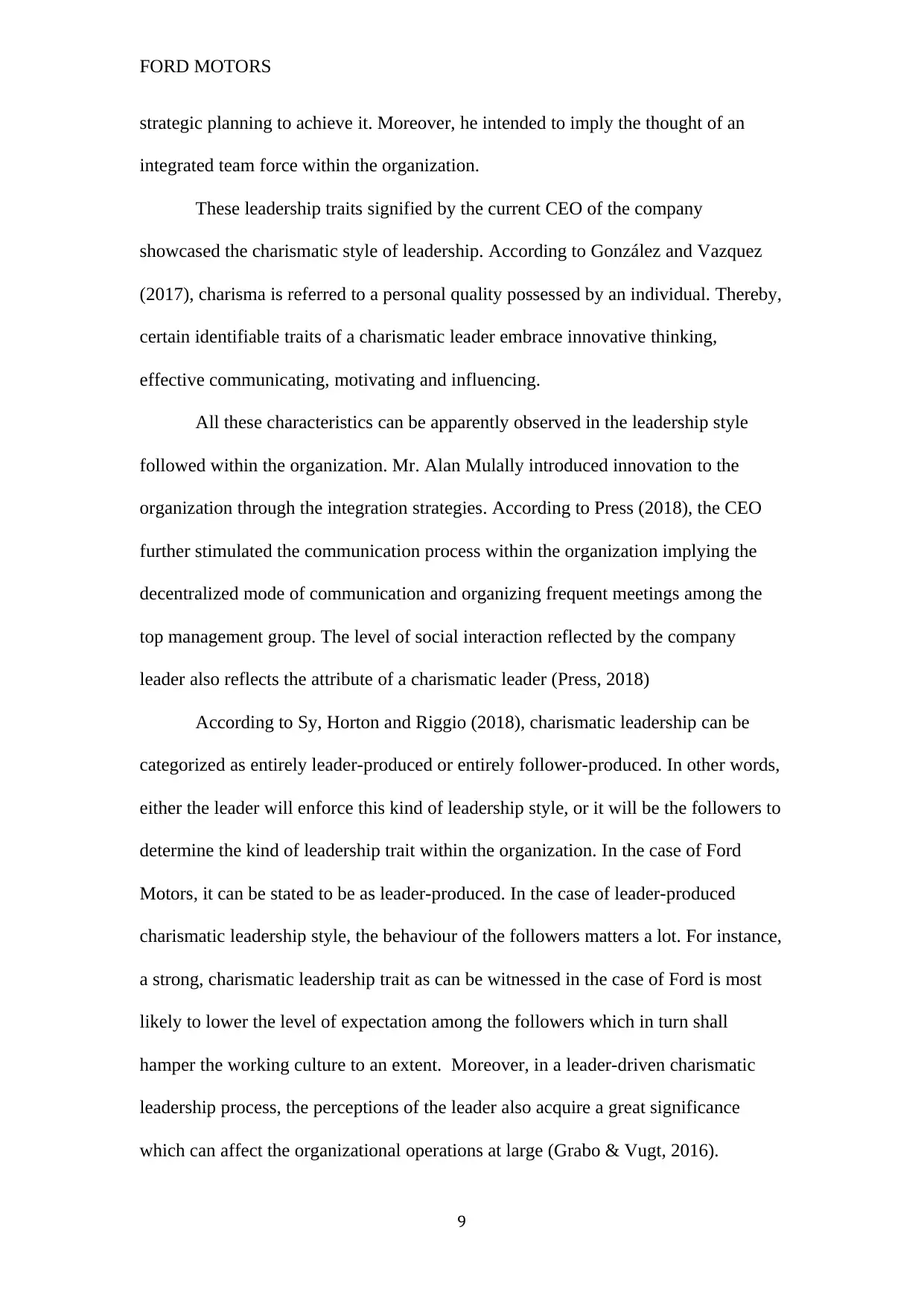
FORD MOTORS
strategic planning to achieve it. Moreover, he intended to imply the thought of an
integrated team force within the organization.
These leadership traits signified by the current CEO of the company
showcased the charismatic style of leadership. According to González and Vazquez
(2017), charisma is referred to a personal quality possessed by an individual. Thereby,
certain identifiable traits of a charismatic leader embrace innovative thinking,
effective communicating, motivating and influencing.
All these characteristics can be apparently observed in the leadership style
followed within the organization. Mr. Alan Mulally introduced innovation to the
organization through the integration strategies. According to Press (2018), the CEO
further stimulated the communication process within the organization implying the
decentralized mode of communication and organizing frequent meetings among the
top management group. The level of social interaction reflected by the company
leader also reflects the attribute of a charismatic leader (Press, 2018)
According to Sy, Horton and Riggio (2018), charismatic leadership can be
categorized as entirely leader-produced or entirely follower-produced. In other words,
either the leader will enforce this kind of leadership style, or it will be the followers to
determine the kind of leadership trait within the organization. In the case of Ford
Motors, it can be stated to be as leader-produced. In the case of leader-produced
charismatic leadership style, the behaviour of the followers matters a lot. For instance,
a strong, charismatic leadership trait as can be witnessed in the case of Ford is most
likely to lower the level of expectation among the followers which in turn shall
hamper the working culture to an extent. Moreover, in a leader-driven charismatic
leadership process, the perceptions of the leader also acquire a great significance
which can affect the organizational operations at large (Grabo & Vugt, 2016).
9
strategic planning to achieve it. Moreover, he intended to imply the thought of an
integrated team force within the organization.
These leadership traits signified by the current CEO of the company
showcased the charismatic style of leadership. According to González and Vazquez
(2017), charisma is referred to a personal quality possessed by an individual. Thereby,
certain identifiable traits of a charismatic leader embrace innovative thinking,
effective communicating, motivating and influencing.
All these characteristics can be apparently observed in the leadership style
followed within the organization. Mr. Alan Mulally introduced innovation to the
organization through the integration strategies. According to Press (2018), the CEO
further stimulated the communication process within the organization implying the
decentralized mode of communication and organizing frequent meetings among the
top management group. The level of social interaction reflected by the company
leader also reflects the attribute of a charismatic leader (Press, 2018)
According to Sy, Horton and Riggio (2018), charismatic leadership can be
categorized as entirely leader-produced or entirely follower-produced. In other words,
either the leader will enforce this kind of leadership style, or it will be the followers to
determine the kind of leadership trait within the organization. In the case of Ford
Motors, it can be stated to be as leader-produced. In the case of leader-produced
charismatic leadership style, the behaviour of the followers matters a lot. For instance,
a strong, charismatic leadership trait as can be witnessed in the case of Ford is most
likely to lower the level of expectation among the followers which in turn shall
hamper the working culture to an extent. Moreover, in a leader-driven charismatic
leadership process, the perceptions of the leader also acquire a great significance
which can affect the organizational operations at large (Grabo & Vugt, 2016).
9
Paraphrase This Document
Need a fresh take? Get an instant paraphrase of this document with our AI Paraphraser

FORD MOTORS
Grabo, Spisak and Vugt (2017), stated that charismatic leaders possess certain
serious drawbacks. Notably, it is assumed that the charismatic leaders have a strong
impact on their followers, which denotes that his actions shall not only generate
positive attitude among the fellow workers but shall also provide rise to certain
influential negative thoughts hampering the organizational culture at large. Moreover,
charismatic leaders intend to control their subordinates strongly which is accumulated
with the prospective lacuna of accountability. It is due to the reason that it is quite
difficult to account the fixed certainty of the charismatic leaders.
The internal problem that the company witnessed can be illustrated as the
power of leadership and communication which led the company to a rapid downfall
and then again pulling it back to its position in the global platform. For instance, the
strategies adopted by the company leader during 2000 focused on the marketing
strategies of the company raising multiple questions regarding the company’s welfare
in the international market. Consequently, this fueled the dissatisfaction level within
the organizational hierarchy. It was thus ineffective. The next leader decided to raise a
huge loan from putting most of its assets on a stake as a precaution to the most
probable emergence of a global recession. Prima facie it was remarked to be
unnecessary by most of the company officials and external analysts, the amount
adopted as a loan, fortunately, saved the company from coming across the major
obstacles of the incident similar to its competitors. In the words of Mr. Alan Mulally,
the amount was accepted “as a cushion to protect for a recession or other unexpected
event." (Vlasic, 2018).
This proved to be quite beneficial in supporting the company against the
external fluctuation emerging in the market during the period. Hence, it was again the
effective leadership and the communication process which assisted the company in
10
Grabo, Spisak and Vugt (2017), stated that charismatic leaders possess certain
serious drawbacks. Notably, it is assumed that the charismatic leaders have a strong
impact on their followers, which denotes that his actions shall not only generate
positive attitude among the fellow workers but shall also provide rise to certain
influential negative thoughts hampering the organizational culture at large. Moreover,
charismatic leaders intend to control their subordinates strongly which is accumulated
with the prospective lacuna of accountability. It is due to the reason that it is quite
difficult to account the fixed certainty of the charismatic leaders.
The internal problem that the company witnessed can be illustrated as the
power of leadership and communication which led the company to a rapid downfall
and then again pulling it back to its position in the global platform. For instance, the
strategies adopted by the company leader during 2000 focused on the marketing
strategies of the company raising multiple questions regarding the company’s welfare
in the international market. Consequently, this fueled the dissatisfaction level within
the organizational hierarchy. It was thus ineffective. The next leader decided to raise a
huge loan from putting most of its assets on a stake as a precaution to the most
probable emergence of a global recession. Prima facie it was remarked to be
unnecessary by most of the company officials and external analysts, the amount
adopted as a loan, fortunately, saved the company from coming across the major
obstacles of the incident similar to its competitors. In the words of Mr. Alan Mulally,
the amount was accepted “as a cushion to protect for a recession or other unexpected
event." (Vlasic, 2018).
This proved to be quite beneficial in supporting the company against the
external fluctuation emerging in the market during the period. Hence, it was again the
effective leadership and the communication process which assisted the company in
10
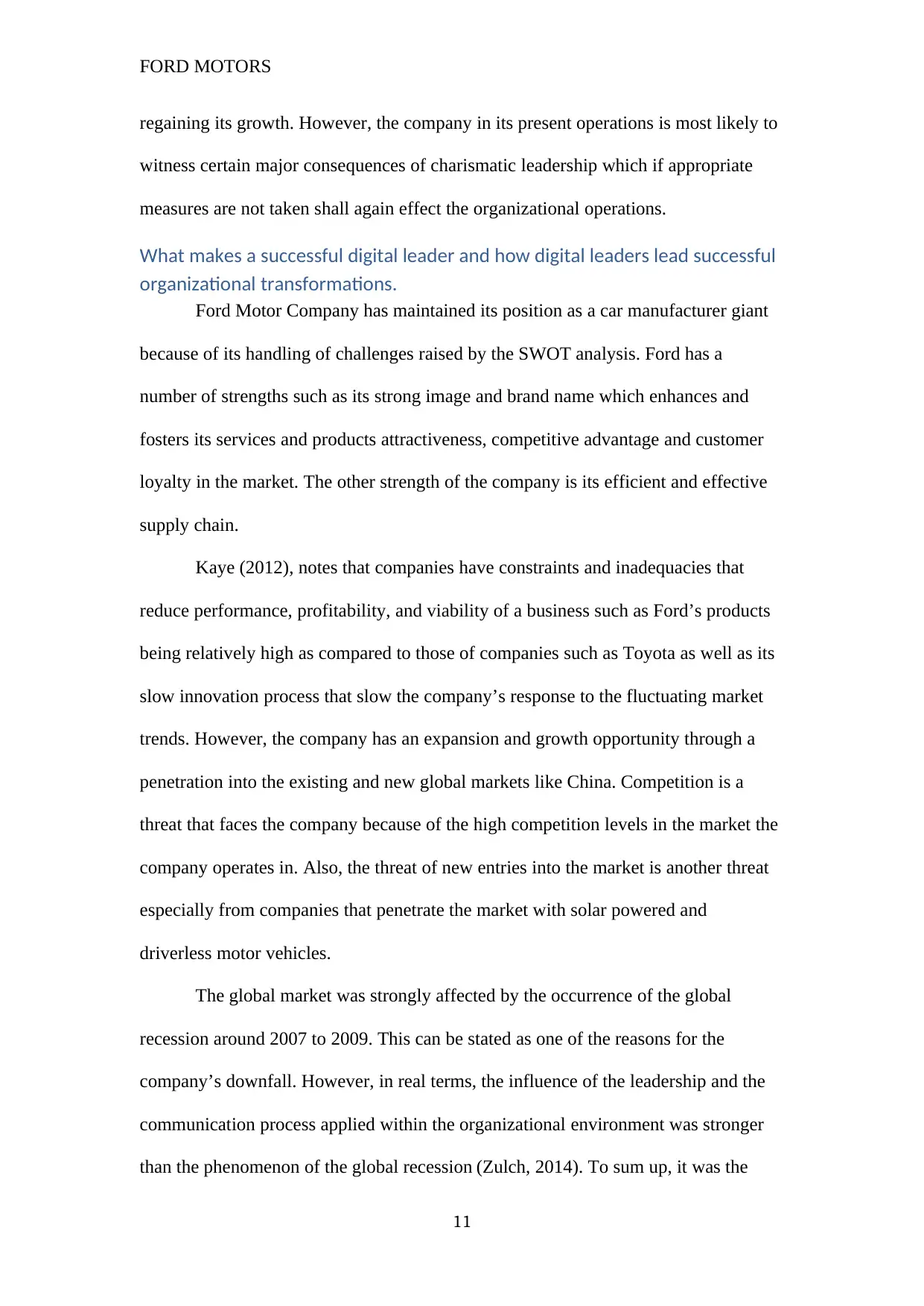
FORD MOTORS
regaining its growth. However, the company in its present operations is most likely to
witness certain major consequences of charismatic leadership which if appropriate
measures are not taken shall again effect the organizational operations.
What makes a successful digital leader and how digital leaders lead successful
organizational transformations.
Ford Motor Company has maintained its position as a car manufacturer giant
because of its handling of challenges raised by the SWOT analysis. Ford has a
number of strengths such as its strong image and brand name which enhances and
fosters its services and products attractiveness, competitive advantage and customer
loyalty in the market. The other strength of the company is its efficient and effective
supply chain.
Kaye (2012), notes that companies have constraints and inadequacies that
reduce performance, profitability, and viability of a business such as Ford’s products
being relatively high as compared to those of companies such as Toyota as well as its
slow innovation process that slow the company’s response to the fluctuating market
trends. However, the company has an expansion and growth opportunity through a
penetration into the existing and new global markets like China. Competition is a
threat that faces the company because of the high competition levels in the market the
company operates in. Also, the threat of new entries into the market is another threat
especially from companies that penetrate the market with solar powered and
driverless motor vehicles.
The global market was strongly affected by the occurrence of the global
recession around 2007 to 2009. This can be stated as one of the reasons for the
company’s downfall. However, in real terms, the influence of the leadership and the
communication process applied within the organizational environment was stronger
than the phenomenon of the global recession (Zulch, 2014). To sum up, it was the
11
regaining its growth. However, the company in its present operations is most likely to
witness certain major consequences of charismatic leadership which if appropriate
measures are not taken shall again effect the organizational operations.
What makes a successful digital leader and how digital leaders lead successful
organizational transformations.
Ford Motor Company has maintained its position as a car manufacturer giant
because of its handling of challenges raised by the SWOT analysis. Ford has a
number of strengths such as its strong image and brand name which enhances and
fosters its services and products attractiveness, competitive advantage and customer
loyalty in the market. The other strength of the company is its efficient and effective
supply chain.
Kaye (2012), notes that companies have constraints and inadequacies that
reduce performance, profitability, and viability of a business such as Ford’s products
being relatively high as compared to those of companies such as Toyota as well as its
slow innovation process that slow the company’s response to the fluctuating market
trends. However, the company has an expansion and growth opportunity through a
penetration into the existing and new global markets like China. Competition is a
threat that faces the company because of the high competition levels in the market the
company operates in. Also, the threat of new entries into the market is another threat
especially from companies that penetrate the market with solar powered and
driverless motor vehicles.
The global market was strongly affected by the occurrence of the global
recession around 2007 to 2009. This can be stated as one of the reasons for the
company’s downfall. However, in real terms, the influence of the leadership and the
communication process applied within the organizational environment was stronger
than the phenomenon of the global recession (Zulch, 2014). To sum up, it was the
11
⊘ This is a preview!⊘
Do you want full access?
Subscribe today to unlock all pages.

Trusted by 1+ million students worldwide
1 out of 20
Related Documents
Your All-in-One AI-Powered Toolkit for Academic Success.
+13062052269
info@desklib.com
Available 24*7 on WhatsApp / Email
![[object Object]](/_next/static/media/star-bottom.7253800d.svg)
Unlock your academic potential
Copyright © 2020–2025 A2Z Services. All Rights Reserved. Developed and managed by ZUCOL.




